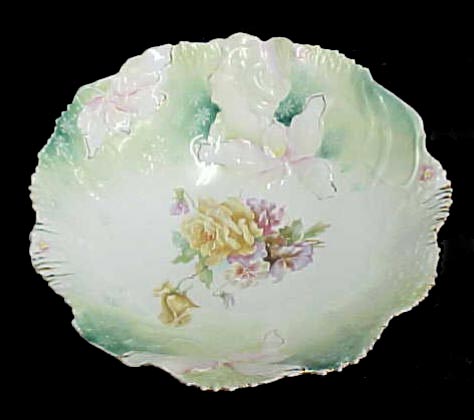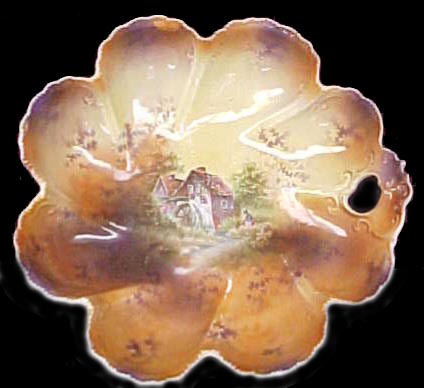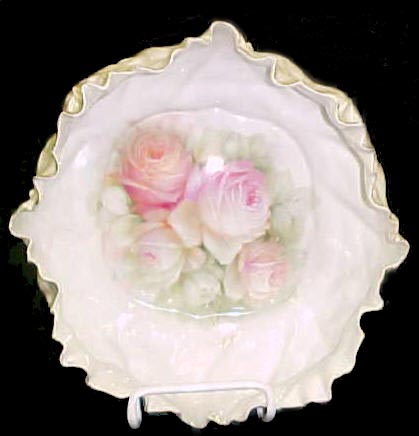







RS Prussia porcelain has been popular in the United States for over 100 years.
During the height of their production and popularity, the mold designs were
quite ornate and lovely and a good number of them show a strong Art Nouveau
influence. The pieces are decorated with transfer designs that are quite
lush and eye-catching; the most desirable pieces incorporate portraits or
animal motifs, though the floral designs are nevertheless quite lovely too.
They were sold for premium prices in their day; RS Prussia has never been
“cheap”.
Reinhold Schlegelmilch opened a factory in Suhl, in the province of Thuringia
Germany in 1969. In 1894 he opened a second factory in Tillowitz in upper
Silesia, Germany. Both of these areas had plenty of raw materials to create
hard-paste porcelain. Interestingly, there is some confusion today about
another company in the region; several sources list Erdmann Schlegelmilch
as Reinhold’s brother and fellow porcelain manufacturer. However, the book
RS Prussia: The Formative Years by Leland and Carol Maple says that
Erdmann was no relation and not connected to RS Prussia porcelain- he simply
had a nearby factory and the same last name as Reinhold.
The items produced by the RS Prussia firm between 1900 and 1910 are by far
the most popular with collectors, and the easiest to find. The 1900-1905
was the height of the Art Nouveau designs they created and thus arguably
the period of production that is most sought after today. Before around 1900,
RS Prussia was rarely exported into the united states; after 1910, the previous
ornate molds were entirely replaced with plain, undecorated molds. 1910-1915
production however is reasonably priced in comparison to the higher priced
and more popular early period. In 1915, the Shul factory closed due to WWI.
The system of marks used by RS Prussia is complex and confusing. Suffice
it to say that opening a book and spending some quality time researching
is your best bet if you would like to learn more about them. A whole article
could be written simply about the subject. The mark that is most recognized
by collectors today is the Wreath and Star, usually two color, with the words
RS Prussia. However, there are a host of other marks, and many, many pieces
were not marked at all. For the experienced collector, the unmarked pieces
are as desirable as the marked depending on their motif. Many of the transfer
patterns are instantly recognizable, as are many of the mold shapes. A reference
book on RS Prussia is very helpful for those, especially for the collector
who is just starting out.
Some of the harder to find pieces are the Four Seasons, which depict a lovely
Gibson style girl in a landscape that matches the season. For instance a
chocolate pot with Winter on it books for $3,500. Also popular, and desirable,
are Murillo painting reproductions like “The Melon Eaters”, and “The Dice
Throwers”-both of which depict groups of you, chubby, almost cupid-like boys.
There is also an extremely hard to find transfer of Rembrandt’s “The Night
Watch”. There are other portrait types of RS Prussia, with images of Gibson
girls and lovely Victorian ladies, all of which are excellent and highly
prized pieces.
Scenic transfer designs are also desirable- for example, there are various
landscape transfers like “The Castle”, or “Cherry Blossom Time”, which are
also popular with collectors and not terribly common. There are also some
bird and animal designs, which can range from very, very hard
to find and quite desirable like “Tigers”, to more typical (yet still collectable)
swan motifs. The prices can range from multiple thousands to the mid-hundreds.
Ostriches are definitely a find; parrots are another popular pattern, but
not quite as much as the ostriches.
The typical floral transfers are beautiful and ornate, brilliantly colored
usually and often with “shadow leaves” (a common RS Prussia transfer motif).
The shadow leaves are basically a silhouette of a leaf that blends into the
background- it almost looks like someone put a leaf on the item and spray
painted around it, leaving a soft silhouette of negative space. The floral
motifs are popular, but much more common and less highly priced that the
other designs RS Prussia created. Depending on the mold, however, they can
be quite desirable. They also are more easily accessible for the new collector-
one can build a nice collection of floral design items for the price of one
figural motif piece.
One very hard to find, and absolutely stunning mold is the “Hidden Image”
bowl- a woman’s face hides in the shape of the piece surrounded by flowers.
The hidden image mold is very Art Nouveau looking- it is much more asymmetrical
than most RS Prussia. A rule of thumb is that the more ornate and deeper
relief the mold, the better. (This is of course not always true).
RS Prussia has experienced a lull of interest in the past couple of years-
consequently this is a great time to start collecting. You are likely to
find items under book value out there, and plenty of merchandise to choose
from. An educated collector has an advantage. I would highly recommend doing
some reading on this fascinating area of porcelain. Check out the series
of books by Leland and Carol Maple. They include RS Prussia: The Formative
Years and RS Prussia Wreath and Star.
Shop for RS Prussia and 16,500 antiques on our website: